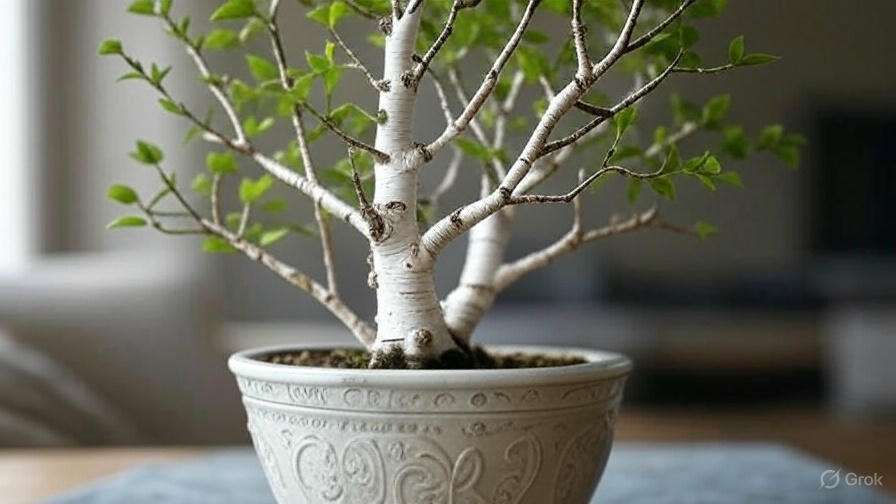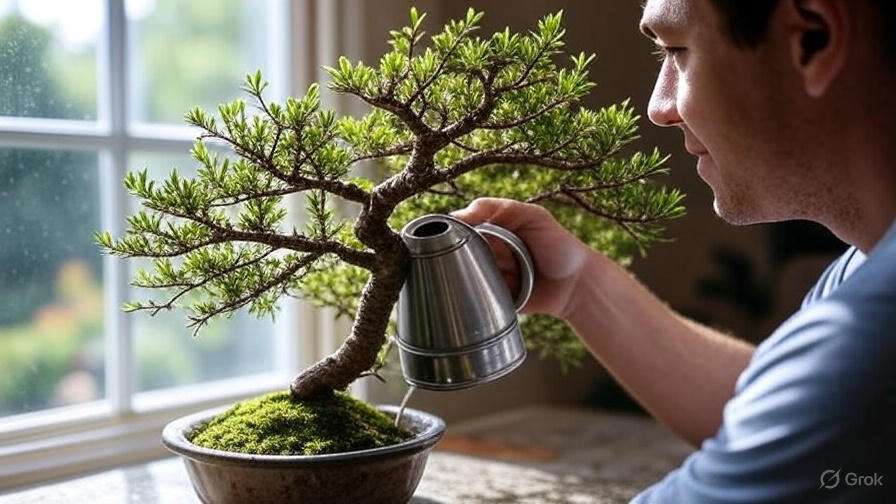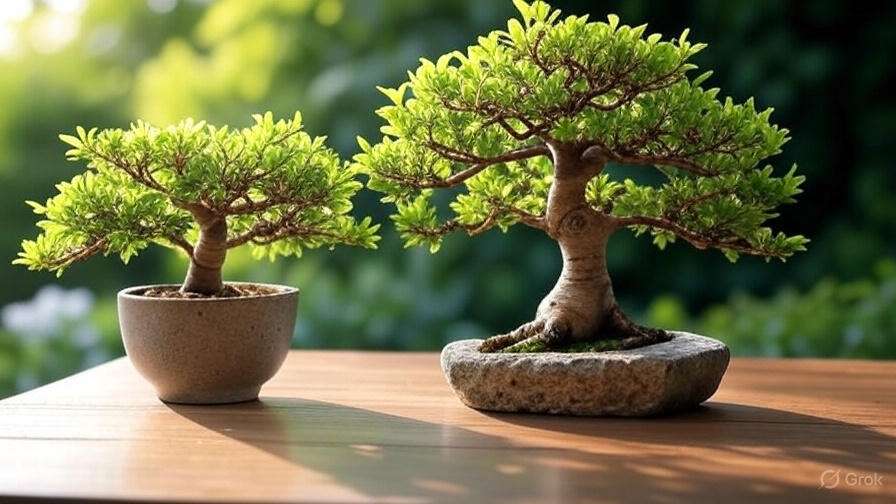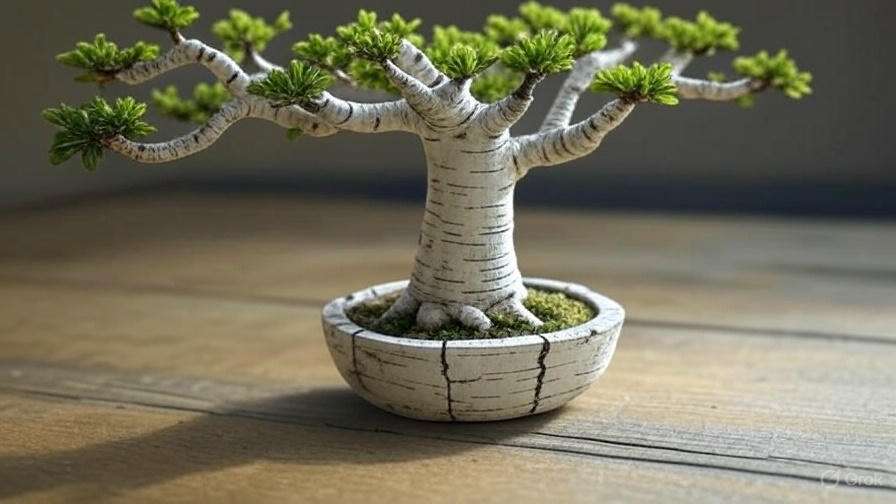
How to Grow and Care for a Bonsai Tree Birch: A Complete Guide
Are you looking to bring the timeless elegance of a bonsai into your home? A bonsai tree birch is a perfect choice for adding natural beauty and tranquility to your space, whether you’re a seasoned gardener or a complete beginner. With its delicate, leafy branches and unique appearance, this miniature tree offers the charm of a full-sized birch tree in a manageable, indoor-friendly form.
However, growing and caring for a bonsai tree birch can seem tricky if you’re unfamiliar with its specific needs. But don’t worry! This complete guide will walk you through everything you need to know—from selecting the right tree to mastering the art of pruning and watering.
By the end of this guide, you’ll have the knowledge and confidence to cultivate a thriving bonsai tree birch that’s both beautiful and long-lasting. Let’s dive in!
Table of Contents
ToggleWhat is a Bonsai Tree Birch? 
A Bonsai Tree Birch is a miniature version of the majestic birch tree, traditionally grown and shaped through the art of bonsai. Bonsai, a Japanese practice, involves cultivating small trees that mimic the size and appearance of full-grown trees in nature. While the concept might sound complex, creating a Bonsai Tree Birch is quite achievable, even for beginners!
The Bonsai Birch specifically refers to a Betula species, most commonly the European Birch (Betula pendula) or the Silver Birch (Betula alba), which are known for their distinctive white bark and delicate leaves. These trees are prized for their striking appearance and adaptability to bonsai styling techniques.
Key Characteristics of a Bonsai Tree Birch 
- Unique Bark: The standout feature of a Bonsai Birch is its beautiful, white or silver bark, which peels in thin strips as it matures. This gives it a highly decorative and textured look.
- Graceful Leaves: The leaves of a Birch Bonsai are small and triangular-shaped, turning vibrant yellow in the fall, making them a visually appealing addition to your home or garden.
- Resilience: Birch trees are hardy, making them relatively easy to care for compared to other bonsai species. They can thrive in various climates and environments with proper care.
- Natural Elegance: With its slender branches and graceful form, a Bonsai Tree Birch brings a natural elegance to any space, creating a peaceful and calming atmosphere.
Bonsai Birch Care Tips 
- Lighting: Birch trees love bright, indirect light. Ensure your Bonsai Birch is placed near a window where it can get plenty of light, but avoid direct, harsh sunlight.
- Watering: Keep the soil consistently moist but not soggy. Birch trees do well with regular watering, especially during the growing season.
- Pruning: Regular trimming is essential to maintain the shape and size of your Bonsai Birch. Prune new growth to encourage a more compact form.
- Temperature: Birch trees prefer cooler temperatures. They can handle mild frosts, but if you’re growing your Bonsai indoors, keep the room temperature between 60°F and 75°F (15°C to 24°C).
Why Choose a Bonsai Tree Birch? 
- Aesthetic Appeal: With its elegant appearance and beautiful bark, the Bonsai Birch adds an eye-catching touch to any home décor.
- Low Maintenance: For a bonsai tree, the Birch is relatively low-maintenance, making it a great option for beginners.
- Timeless Beauty: The natural beauty of a Bonsai Birch tree is evergreen, offering aesthetic value throughout the seasons.
Whether you’re an experienced bonsai grower or just starting, a Bonsai Tree Birch can be a rewarding and stunning addition to your collection. Its timeless beauty and ease of care make it a perfect choice for anyone looking to bring a little nature indoors.
Choosing the Right Bonsai Tree Birch 
When selecting a bonsai tree, especially a Birch bonsai, it’s crucial to make an informed choice to ensure you get a healthy, vibrant tree that thrives in your home or garden. Here’s a simple guide to help you choose the perfect LED Birch Tree for your space, whether you’re a first-time grower or an experienced enthusiast.
1. Consider the Environment
Bonsai trees, including birches, need the right environment to flourish. LED Birch Trees are a fantastic choice because they can adapt to both indoor and outdoor settings. Here’s what you should think about:
- Indoor Spaces: Choose a smaller birch bonsai with a compact shape. Place it near natural light, but avoid direct sunlight that can scorch the leaves.
- Outdoor Spaces: If you have space outdoors, go for a larger tree. Birches thrive in cooler climates, so make sure the temperature stays between 55°F and 75°F (13°C-24°C).
2. Look for Healthy Foliage 
The leaves of your LED Birch Tree are a clear indicator of its health. Check for vibrant, green leaves without any yellowing or spots. These could be signs of pests or poor care. Healthy birch trees will have smooth, green leaves with a soft texture.
- LED Birch Trees typically have bright LED lights that mimic the glow of sunlight. When shopping for one, ensure the lights are integrated seamlessly into the design.
3. Size Matters
Birch trees come in different sizes, so think about the space where you’ll keep the tree:
- Small Birch Bonsai Trees are ideal for compact spaces like desks, shelves, or apartments.
- Larger Birch Bonsai Trees look great in living rooms, patios, or gardens with plenty of space for growth.
Opt for the size that matches your space and needs.
4. Check the Roots and Trunk
A good Bonsai Birch Tree will have a strong, well-developed root system. Look for a tree with a thick trunk and a balanced root structure. Roots should not be too exposed or tangled.
- If purchasing a live tree, consider the root health before buying.
5. LED Light Features
LED Birch Trees are unique in that they come with integrated lighting features. Here’s what to look for:
- Adjustable Lights: Opt for a tree with lights that you can adjust to fit the ambiance of your space.
- Energy Efficiency: Choose a tree with energy-efficient LEDs that save electricity while providing enough light to enhance the birch’s natural beauty.
6. Ease of Maintenance
Look for birch trees that are easy to maintain. LED Birch Trees are relatively low-maintenance compared to natural plants, but make sure the model you choose is easy to clean and adjust when needed.
- Keep the lights clean to ensure they shine bright and last longer.
7. Price and Value
LED Birch Trees come in various price ranges, depending on the size, features, and brand. While it might be tempting to go for a cheaper option, remember that a high-quality tree will not only last longer but also provide better aesthetic value.
Look for trees with a good balance between cost and features. Quality materials, realistic appearance, and long-lasting LED lights are worth investing in.
By considering these factors, you can select the perfect LED Birch Bonsai Tree that fits your space, lifestyle, and aesthetic preferences. With proper care, your new tree will bring a touch of nature to your home, glowing beautifully with every light!
Essential Tools for Growing Bonsai Tree Birch 
Growing a Bonsai Tree Birch (Betula) is a rewarding yet meticulous task, and having the right tools is key to success. Whether you’re a beginner or an experienced grower, the following tools will make your bonsai care routine smoother, easier, and more enjoyable.
1. Bonsai Shears 
A good pair of bonsai shears is essential for shaping and trimming your birch tree. These shears are specially designed to make precise cuts without damaging the tree. Look for a sharp, lightweight pair that allows for easy maneuvering around delicate branches.
Tip: Trim your birch tree regularly to maintain its shape and encourage healthy growth. Be sure to use clean, sharp shears to avoid causing stress or infection to the tree.
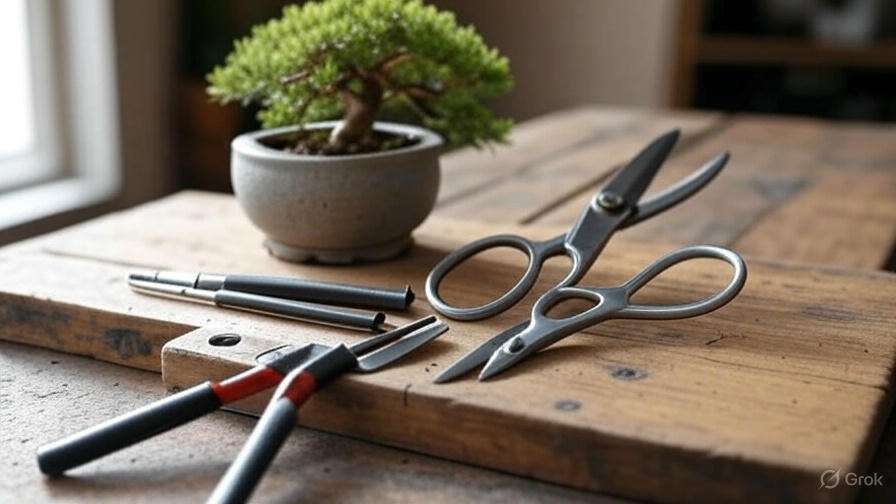
2. Bonsai Wire (Aluminum or Copper) 
Wire is a must-have for guiding the growth of your bonsai. It helps you shape and bend branches without harming them. Aluminum wire is softer and easier to manipulate, while copper wire offers more control but requires a bit more care.
Tip: Always wrap the wire gently around the branches to avoid cutting into the bark. Don’t leave the wire on for too long to prevent marks on your tree.
3. Bonsai Root Rake and Spade 
To keep the root system of your birch healthy, a root rake and spade are indispensable. These tools help with root pruning and re-potting, essential for maintaining proper growth and preventing root rot.
Tip: Gently tease out the roots during re-potting to promote healthy new growth. Be careful not to damage the root ball.
4. Bonsai Pot 
Choosing the right pot is crucial for your birch tree’s health. A pot with good drainage ensures that water doesn’t accumulate at the bottom, preventing root rot. Bonsai pots are shallow and often come with drainage holes, which help oxygen flow to the roots.
Tip: Ensure the pot is about 1.5-2 times the size of your tree’s root ball. This gives enough space for growth without overwhelming the tree.
5. Soil Mix 
The right soil mix is vital for your Bonsai Tree Birch. A mix that drains well but also retains enough moisture is ideal. A common blend includes akadama (clay), pumice, and lava rock. This combination provides a balance of water retention and aeration.
Tip: Always check the moisture level of the soil. Birch trees prefer moist, but not waterlogged, conditions.
6. Watering Can 
A good watering can with a fine spout is essential for watering your bonsai. The gentle stream ensures even moisture distribution, preventing soil from being displaced or over-saturated.
Tip: Water your tree thoroughly until water runs out of the drainage holes. Always let the soil dry slightly between waterings, but avoid letting it dry out completely.
7. Humidity Tray 
Bonsai trees, including Birch, thrive in a humid environment. A humidity tray placed beneath the pot helps maintain moisture levels around the tree, especially in dry indoor environments.
Tip: Place some decorative pebbles in the tray, and make sure the pot doesn’t sit directly in the water. The idea is to increase the humidity around the tree without waterlogging the roots.
8. Bonsai Concave Cutter 
For precise, clean cuts on thick branches or roots, a concave cutter is a game-changer. It removes unwanted branches without leaving large scars, promoting faster healing for your tree.
Tip: Use the concave cutter for larger cuts and always cut at a slight angle to ensure the wound heals properly.
Final Thoughts 
Having the right tools for your Bonsai Tree Birch can significantly enhance the care process and ensure your tree grows strong, healthy, and beautiful. Start with these essential tools, and you’ll be on your way to becoming a bonsai expert in no time!
By regularly trimming, shaping, and re-potting your tree, you’ll keep it thriving for years to come.
How to Plant and Pot Your Bonsai Tree Birch 
Planting and potting your Bonsai Birch tree is an exciting part of growing your indoor garden. With the right steps, you can create a beautiful, healthy Bonsai tree that enhances your home. Whether you’re a beginner or an experienced grower, this guide will take you through the process step-by-step.
1. Choose the Right Pot 
First things first, select a pot that suits your Bonsai tree. For a Birch Bonsai, choose a shallow, well-draining pot—typically about 2/3 the size of the tree’s root system. Look for a pot with drainage holes to prevent water from collecting at the bottom, which can cause root rot.
Tip: If you’re unsure, go for a ceramic pot—it helps regulate moisture levels and keeps the tree’s roots cool.

2. Prepare the Soil 
Bonsai trees like their soil to be light, airy, and fast-draining. A mix of akadama (Japanese clay), pumice, and lava rock is ideal for Birch Bonsai trees. This blend provides the right balance of drainage and moisture retention, allowing your tree to thrive. You can also find pre-mixed Bonsai soil at your local nursery or online.
Tip: Avoid using regular potting soil as it holds too much moisture, which can suffocate the roots.
3. Trim the Roots 
Before planting your Bonsai tree, gently remove it from its nursery container. Examine the roots and trim any long, unhealthy, or tangled roots. The goal is to create a compact root system that will thrive in the shallow pot. Be sure to leave enough roots for the tree to stay stable but prune excess growth to encourage better growth.
Tip: Always use clean, sharp scissors or pruning shears to avoid damaging the roots.
4. Place the Tree in the Pot 
Now, it’s time to position your Bonsai tree in the pot. Fill the bottom of the pot with a thin layer of soil to create a base. Then, carefully position the Birch tree in the center, ensuring that the roots are spread evenly. Add soil around the roots and gently press down to eliminate air pockets.
Tip: Ensure the tree is slightly below the rim of the pot, as this will help when watering.
5. Water Your Tree 
After planting, water the Bonsai tree thoroughly. This will help settle the soil around the roots. Watering your Bonsai Birch regularly is crucial, but make sure the soil doesn’t stay soggy. Check the moisture levels often to ensure it’s not too dry or too wet.
Tip: Use a watering can with a fine spout to avoid disturbing the soil.
6. Provide Proper Light 
Bonsai Birch trees need plenty of indirect sunlight to thrive. Place your tree near a window where it gets bright, filtered light for at least 4-6 hours a day. Direct sunlight can burn the leaves, so avoid placing it in direct sunlight for long periods.
Tip: If you live in a darker area, consider using a grow light to supplement natural light.
7. Maintain and Prune Your Tree 
To keep your Bonsai tree healthy and looking its best, you’ll need to prune it regularly. Trim any unwanted branches, leaves, or roots to maintain its shape and size. This encourages new growth and keeps the tree compact and balanced.
Tip: Always prune your Bonsai after it’s finished blooming, usually in early spring.
By following these simple steps, you can successfully plant and pot your Bonsai Birch tree! 
If you found this guide helpful, check out more expert tips on Bonsai care and other beautiful indoor plants in our full guide to LED Birch trees for home décor.
Watering Your Bonsai Tree Birch 
When it comes to caring for your LED Birch Tree Bonsai, one of the most crucial aspects is watering. It might seem simple, but getting it right will ensure your tree stays healthy and vibrant! Here’s how to do it:
1. Check the Soil Moisture 
Before you water, always check the soil’s moisture level. Stick your finger into the soil up to about 1 inch deep. If it feels dry, it’s time to water. If it’s still damp, wait another day or two.
2. Water Thoroughly 
When you water, make sure to do it thoroughly. Pour water around the base of the tree until it drains from the bottom of the pot. This ensures that the roots receive enough moisture. Don’t just water the surface!
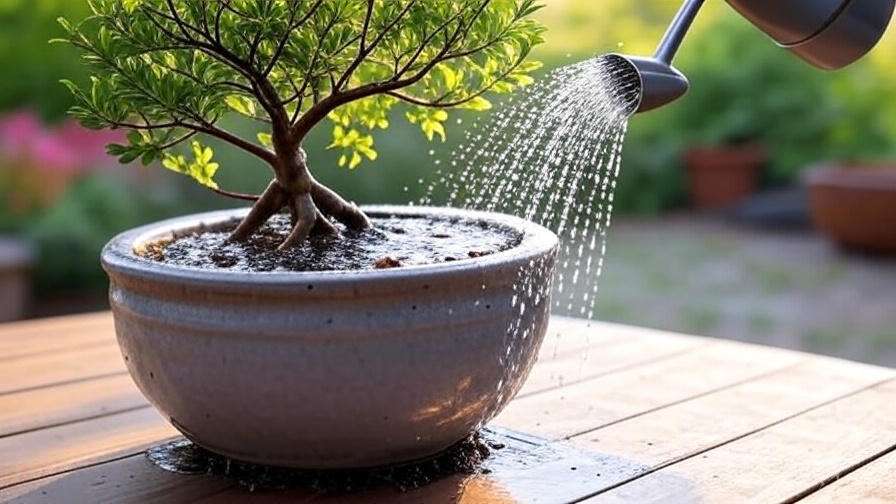
3. Use Room Temperature Water 
Avoid using cold water directly from the tap, as it can shock the roots. Instead, use water at room temperature. This helps the tree absorb moisture more effectively.
4. Water Frequency 
Birch trees don’t like being too dry or too wet. In general, water your LED Birch Bonsai once every 2-3 days, depending on the environment. If it’s hot and dry, you may need to water more frequently. During cooler months, reduce the watering frequency.
5. Consider the Climate 
If your home is very dry (due to air conditioning or heating), your tree will require more frequent watering. In more humid climates, less water might be needed. Keep an eye on the tree and adjust based on the conditions.
6. Avoid Overwatering 
Overwatering can lead to root rot, which is a common issue with bonsais. Always ensure the pot has proper drainage, and never let water accumulate at the bottom.
7. Use a Humidity Tray 
If your indoor space is very dry, consider placing a humidity tray beneath your LED Birch Bonsai. This helps maintain moisture in the air around your tree, creating a more comfortable environment.
Pro Tip: Keep a consistent watering schedule to help your bonsai thrive. Bonsais are sensitive to sudden changes in care, so gradual adjustments work best! 
By following these simple watering tips, your LED Birch Tree Bonsai will flourish and bring a touch of nature to your home for years to come!
Light and Temperature Needs 
When choosing the perfect LED birch trees for your home, understanding their light and temperature preferences is key to ensuring they thrive and enhance your space. Here’s a straightforward guide to help you create the ideal environment for your LED birch trees:
Light Requirements 
LED birch trees need adequate lighting to shine brightly and look their best, but not all light is created equal. Here’s what you should know:
- Natural Light is Best: Place your LED birch trees in a spot that receives indirect natural light. Bright, indirect light simulates the natural conditions where birch trees thrive. A spot near a window but out of direct sunlight is ideal.
- Avoid Direct Sunlight: While sunlight is beneficial for most plants, it can be too harsh for LED birch trees, especially those with artificial foliage. Direct sunlight may cause the lights to overheat and affect the longevity of the LED lights.
- Artificial Light Works: If your space lacks natural light, don’t worry! LED birch trees can adapt to artificial lighting. Just ensure they’re placed under a gentle, non-heat producing light source, like an LED bulb. Too much exposure to incandescent or halogen lights may lead to overheating and damage.
Temperature Needs 
Maintaining the right temperature is crucial to the longevity of your LED birch tree. Here are the essential temperature guidelines:
- Optimal Temperature: Keep your LED birch trees in a room where the temperature ranges from 60°F to 75°F (15°C to 24°C). This range is perfect for both the lights and the artificial foliage to last longer without any risk of overheating.
- Avoid Extreme Temperatures: Both high heat and extreme cold can cause damage. Never place your LED birch tree near a heater, air conditioner, or in direct drafts. Such temperature fluctuations can affect the LED lights and even lead to premature failure.
- Consistent Temperature: Try to maintain a consistent temperature in the room. Extreme shifts, like moving your LED birch tree from a cold room to a heated one, could stress the lights and lead to performance issues.
Quick Tip 
If you have your LED birch tree in a room that gets chilly at night, consider placing it near a wall or using a gentle space heater (away from the tree) to maintain a stable environment. This can help avoid sudden drops in temperature that might cause issues.
By carefully managing light and temperature conditions, your LED birch tree will remain bright and beautiful, enhancing your home’s ambiance year-round!
Pruning and Shaping Your Bonsai Tree Birch 
Pruning and shaping your Birch Bonsai tree are essential steps in maintaining its health and aesthetic appeal. When done right, it can elevate the look of your tree, making it a true focal point in your home. Here’s how you can do it effectively.
Why Pruning Is Important 
Pruning doesn’t just keep your Birch Bonsai tree looking beautiful; it also promotes better growth by removing dead or unhealthy branches. Regular trimming helps the tree to develop a fuller canopy and encourages the growth of new, healthy shoots.
How to Prune Your Birch Bonsai Tree 
- Use the Right Tools: Always use sharp, clean pruning shears to avoid damaging the tree. A pair of concave cutters can help make clean cuts that heal better.
- Remove Dead or Damaged Branches: Start by cutting away any dead or unhealthy branches. This prevents disease and encourages healthy growth.
- Cut Above the Node: When trimming, always cut above a node (the small bump where a leaf or branch grows). This will ensure new growth appears in the right places.
- Shape the Tree Gradually: Birch Bonsais naturally grow with a delicate and graceful shape, so avoid over-pruning. Focus on removing stray branches and leaves to maintain the tree’s natural form.
- Prune Regularly, but Not Excessively: Keep an eye on your tree, pruning a little at a time. Over-pruning can stress the tree, while under-pruning can lead to overcrowding.
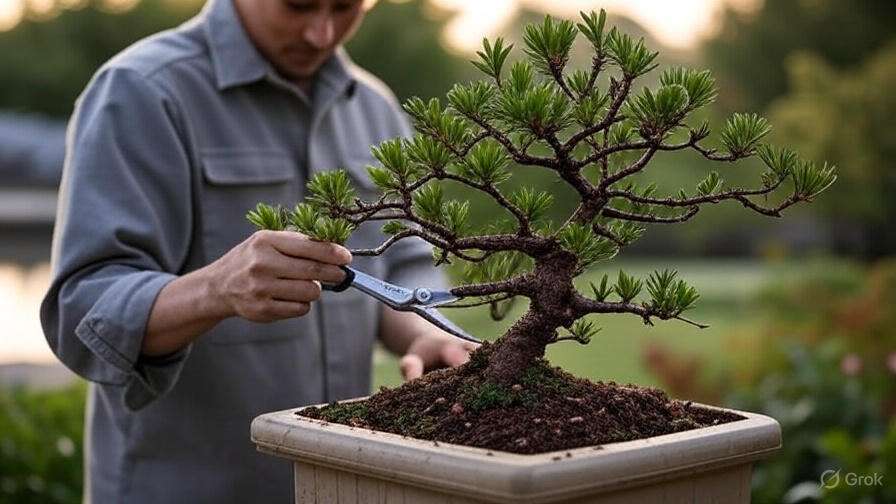
Shaping Your Birch Bonsai 
Shaping your Bonsai is just as important as pruning. It defines the tree’s structure and ensures it grows in the right direction.
- Start Young: The earlier you start shaping, the easier it is to guide the growth of your Birch Bonsai. This is when the tree is most flexible.
- Pinching and Wiring: Gently pinch the growing tips of branches to encourage bushier growth. If needed, use thin wire to bend branches into the desired position. Be sure to remove the wire after a few months to prevent damage.
- Create a Natural Form: Aim for a shape that mimics the natural growth of a mature Birch tree. A straight trunk with gently curved branches looks most appealing.
- Balance is Key: As you shape, keep in mind that balance is crucial. Avoid making one side too heavy with foliage or too sparse. A well-balanced Birch Bonsai will look more symmetrical and healthy.
Best Time for Pruning and Shaping 
The best time to prune and shape your Birch Bonsai is in late spring or early summer, when the tree is actively growing. Avoid heavy pruning during the dormant winter months.
Aftercare 
Once you’ve pruned and shaped your Birch Bonsai, take good care of it. Keep it in a spot where it gets plenty of indirect light and ensure it’s watered regularly, but not overwatered. Fertilize every few weeks to encourage new growth.
By following these simple steps, you can keep your Birch Bonsai looking stunning, healthy, and well-shaped. Regular pruning and shaping will make it a cherished addition to your home for years to come.
Fertilizing and Feeding Your Bonsai Tree Birch 
Taking care of your LED Birch Bonsai Tree goes beyond just lighting and watering. Proper fertilization is key to its health and vitality. Here’s a step-by-step guide to keep your little tree thriving!
1. Why Fertilizing is Essential
Bonsai trees, even LED ones, still require nutrients to maintain their lush, vibrant appearance. Fertilizers provide the necessary nutrients for healthy leaf growth, strong roots, and a well-formed structure. Without the right feeding, your tree may become weak and its growth could slow down.
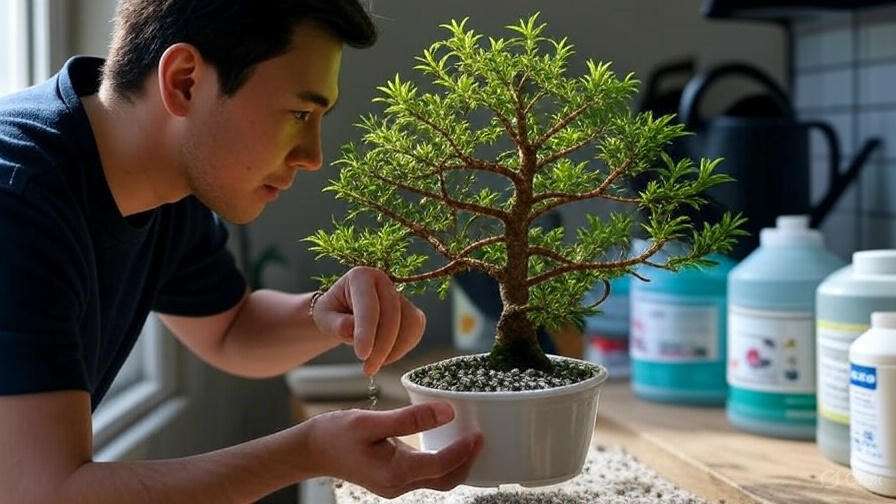
2. When to Fertilize
- Spring and Summer
: These are the active growing seasons for your Birch tree. This is the time to fertilize the most, as the tree uses up more nutrients during growth.
- Fall and Winter
: During these cooler months, the tree is in a dormancy phase, and you should cut back on feeding. Over-fertilizing during these times can stress the tree.
3. Choosing the Right Fertilizer
Select a balanced, water-soluble fertilizer that’s specifically designed for bonsai trees. Look for one with equal parts of Nitrogen (N), Phosphorus (P), and Potassium (K). A typical NPK ratio for bonsai fertilizer is 10-10-10 or 20-20-20.
If you want to boost growth, a high Nitrogen fertilizer (e.g., 30-10-10) is great during the active growing season. For a more robust, mature tree, you can switch to a fertilizer with a lower Nitrogen ratio.
4. How to Apply Fertilizer
- Liquid Fertilizer: Dilute the liquid fertilizer to half-strength and apply it every 2-4 weeks during the growing season.
- Slow-Release Fertilizer: You can use a slow-release granular fertilizer, applying it once every 4-6 weeks. This type is ideal for busy plant parents who may forget to fertilize regularly!
Always water your Bonsai tree well before applying fertilizer to prevent root burn.
5. Signs Your Tree Needs More Fertilizer
- Yellowing Leaves
: If the leaves turn yellow, it could indicate nutrient deficiency, often Nitrogen.
- Stunted Growth: If your Birch tree isn’t growing as expected, it might be time to boost your fertilizing routine.
- Pale or Weak Leaves: This could signal a lack of vital nutrients.
6. Avoid Over-Fertilizing!
While feeding your Bonsai is crucial, too much fertilizer can lead to root burn or damage to the tree. Always follow the recommended amounts and avoid feeding when the tree is dormant in the winter.
7. Organic Alternatives
For a more natural approach, you can use organic fertilizers like compost, worm castings, or fish emulsion. These are gentler on the tree and provide slow-release nutrients over time.
By following these tips, your LED Birch Bonsai tree will stay healthy, strong, and looking its best all year long.
Quick Recap:
- Fertilize during spring and summer, reduce during fall and winter.
- Choose a balanced NPK fertilizer for best results.
- Apply liquid fertilizer every 2-4 weeks or slow-release options every 4-6 weeks.
- Watch for signs of under-fertilization like yellowing leaves or stunted growth.
- Don’t over-fertilize—less is often more!
By keeping your tree well-fed, you’ll ensure it thrives and becomes a stunning focal point in your home!
Common Problems with Bonsai Tree Birch 
Taking care of a bonsai tree, especially a birch, can be a rewarding yet challenging experience. While birch bonsais are known for their striking appearance and elegance, they can also face a range of common issues. Understanding these problems can help you prevent them before they harm your tree. Here are some of the most common problems and how to solve them:
1. Leaf Yellowing 
Yellowing leaves are a common issue, often caused by overwatering or underwatering. Birch trees are sensitive to water stress, and improper watering can lead to root rot or dehydration.
Solution:
- Ensure your bonsai is planted in well-draining soil.
- Water only when the top inch of soil feels dry to the touch. Avoid soggy soil by using a drainage tray.
- Ensure the tree is placed in a location with proper sunlight.

2. Pests and Insects 
Birch bonsai trees, like other bonsai species, can attract pests such as aphids, spider mites, and scale insects. These pests can damage the leaves and affect the overall health of the tree.
Solution:
- Regularly inspect your tree for signs of pests.
- Use organic pest control methods, like neem oil, to treat the affected areas.
- Keep the surrounding area clean to prevent pests from spreading.
3. Poor Root Health 
The roots of a bonsai tree are crucial to its health. If the roots become compacted or diseased, the entire tree can suffer. Birch trees, in particular, need proper root pruning and maintenance to thrive.
Solution:
- Repot your bonsai every two years to avoid rootbound conditions.
- Gently prune any overgrown or damaged roots when repotting.
- Use a well-draining bonsai soil mix to ensure the roots get adequate air circulation.
4. Improper Pruning 
Pruning is an essential aspect of bonsai care, but it can be tricky. Incorrect pruning techniques can harm your tree or cause it to grow in an undesired shape.
Solution:
- Follow proper pruning techniques by removing dead or unhealthy branches first.
- Only prune during the appropriate season, typically in late winter or early spring.
- Avoid over-pruning, which can stress the tree.
5. Overexposure to Direct Sunlight 
While birch bonsais need sunlight to thrive, excessive exposure to direct sunlight can scorch the leaves, leading to brown spots and leaf drop.
Solution:
- Place your bonsai in a spot with bright but indirect light.
- If the tree is kept outdoors, provide some afternoon shade to protect it from harsh sun.
- Keep it indoors near a window with filtered light if it’s too hot outside.
6. Root Rot 
Overwatering is a common cause of root rot, a condition where the roots of your bonsai become waterlogged and start to decompose.
Solution:
- Make sure the bonsai is in a pot with good drainage.
- Allow the soil to dry slightly between waterings.
- Use a soil moisture meter to avoid guessing when it’s time to water.
Conclusion
By understanding and addressing these common issues, you’ll be able to care for your bonsai tree birch more effectively. With the right knowledge and a little patience, your tree will flourish and become a stunning addition to your home.
How to Repot a Bonsai Tree Birch 
Repotting a bonsai tree, like the Birch, is an essential part of keeping your plant healthy and thriving. It might sound complicated, but with the right approach, you can easily refresh your Birch bonsai and help it grow stronger. Here’s a simple guide to help you through the process:
Why Repot a Bonsai Birch?
Repotting gives your bonsai tree fresh soil, more space for its roots to grow, and helps maintain its shape. It’s also a great way to prevent diseases and pests from spreading. Plus, it’s a rewarding way to give your bonsai a new lease on life!

When to Repot Your Bonsai Birch 
Timing is key! The best time to repot a Birch bonsai is during the early spring, just before the tree begins its active growing season. This ensures minimal stress and promotes healthy growth. You should repot every 2 to 3 years, or when you notice the roots outgrowing the pot.
Materials You’ll Need:
- Bonsai Pot: Choose a slightly larger pot than the current one.
- Well-draining Soil: Birch trees thrive in soil that drains well but retains enough moisture.
- Root Pruning Tools: A pair of sharp scissors or bonsai root cutters.
- Wire (optional): To secure your tree in the new pot.
Step-by-Step Guide to Repotting Your Bonsai Birch 
- Prepare Your Tools and Pot:
Gather everything you’ll need—tools, new pot, and fresh soil. Make sure the new pot has drainage holes to prevent waterlogging. - Remove the Tree:
Gently remove your Birch from its current pot. You may need to tap the sides of the pot or use a small tool to loosen the soil around the edges. - Examine the Roots:
Carefully examine the roots for any rot or damage. Trim off any dead or unhealthy roots with your pruning scissors. Be sure not to cut too much—removing 1/3 of the root mass is usually a safe bet. - Prepare the New Pot:
Add a layer of fresh bonsai soil to the bottom of the new pot. This provides a good foundation for the tree’s roots. - Place the Tree in the New Pot:
Position your bonsai Birch in the center of the new pot. Gently spread the roots out evenly across the soil. If needed, use wire to secure the tree in place. - Add Fresh Soil:
Fill the pot with fresh soil, making sure it reaches the root system. Tap the pot lightly to remove any air pockets and ensure the soil is well-packed. - Water Thoroughly:
After repotting, give your bonsai a good watering. This helps settle the soil around the roots and reduces transplant shock. - Place Your Bonsai in a Shaded Area:
For the first few weeks, keep your repotted Bonsai Birch in a shaded area to help it adjust. Gradually move it to a sunnier spot as it recovers.
Tips for a Successful Repotting 
- Don’t Over-Prune the Roots: While root pruning is important, avoid cutting too much at once. Keep the balance to ensure the tree’s health.
- Be Gentle: Birch trees are sensitive. Handle them carefully to avoid damaging delicate roots or branches.
- Use Quality Soil: Invest in high-quality bonsai soil mix to ensure proper drainage and nutrients for your Birch tree.
- Monitor Watering: Keep an eye on your tree’s watering needs after repotting. Over-watering can cause root rot, while under-watering can stress the tree.
Final Thoughts 
Repotting your Bonsai Birch is a simple yet important task that ensures your tree stays healthy and continues to thrive. With a little patience and the right care, your Birch bonsai will grow strong and beautiful for years to come!
Isn’t it satisfying to see your bonsai flourish after a fresh start?
Conclusion
Caring for a bonsai tree birch is not only a rewarding hobby but also a way to bring nature’s elegance into your home. With the right care, such as proper watering, pruning, and lighting, your bonsai tree birch can thrive for years to come, becoming a miniature masterpiece that reflects your dedication. By following the steps outlined in this guide, you’ll be well on your way to creating a stunning bonsai that adds beauty, serenity, and life to your space.

Whether you’re a beginner or an experienced bonsai enthusiast, the bonsai tree birch offers a unique opportunity to deepen your understanding of nature’s intricate details. So, roll up your sleeves, nurture your tree, and watch it flourish into a piece of living art that will bring joy for generations.
Happy bonsai growing!
Frequently Asked Questions(FAQ)
How often should I water my bonsai tree birch?
Watering a bonsai tree birch depends on the environment, but generally, you should water it when the top 1-2 inches of soil feel dry to the touch. During the warmer months, it may need watering more frequently, while in winter, it requires less water. Always ensure the pot has proper drainage to avoid waterlogging.
What is the best soil for a bonsai tree birch?
A bonsai tree birch thrives in well-draining, slightly acidic soil. A good mix includes akadama (a hard-baked clay), pumice, and lava rock. This mix ensures proper drainage and aeration, preventing root rot while providing the nutrients necessary for healthy growth.
How much sunlight does a bonsai tree birch need?
A bonsai tree birch needs bright, indirect sunlight to thrive. Ideally, place it in a spot with 4-6 hours of light per day. Avoid direct, harsh sunlight, which could lead to leaf burn, especially in the summer. In winter, a slightly less sunny spot is acceptable.
How do I prune my bonsai tree birch?
Pruning a bonsai tree birch involves cutting back new growth to maintain its shape and size. Trim away any dead, damaged, or crossing branches. Regular pruning encourages a fuller, healthier tree and helps maintain the miniaturized look of your bonsai. Aim for light pruning every few weeks.
When should I repot my bonsai tree birch?
Bonsai tree birches should be repotted every 2-3 years, preferably during early spring before the growing season starts. Repotting ensures that the roots have enough space to grow, and it provides fresh soil for improved nutrient absorption. Make sure to trim any overly long roots during repotting to encourage a healthy root system.
Can a bonsai tree birch be grown indoors?
While bonsai tree birches can be kept indoors, they generally prefer outdoor environments where they can receive natural light and fresh air. If kept indoors, make sure it gets enough sunlight, and avoid placing it near heat sources or drafts. It’s best to take it outside during the warmer months to ensure healthy growth.
Why are the leaves of my bonsai tree birch turning yellow?
Yellowing leaves on a bonsai tree birch can be a sign of several issues, such as overwatering, poor drainage, or insufficient sunlight. Check the soil moisture and drainage, and ensure your tree is getting the right amount of indirect light. If the issue persists, inspect for pests or consider changing the soil.
How can I prevent pests on my bonsai tree birch?
- Regularly inspect your bonsai tree birch for common pests like aphids, spider mites, or scale insects. To prevent infestations, maintain good tree hygiene by pruning dead leaves and branches. Using organic insecticidal soap or neem oil can help control pests without harming your tree. Always follow the instructions carefully when applying any treatments.

